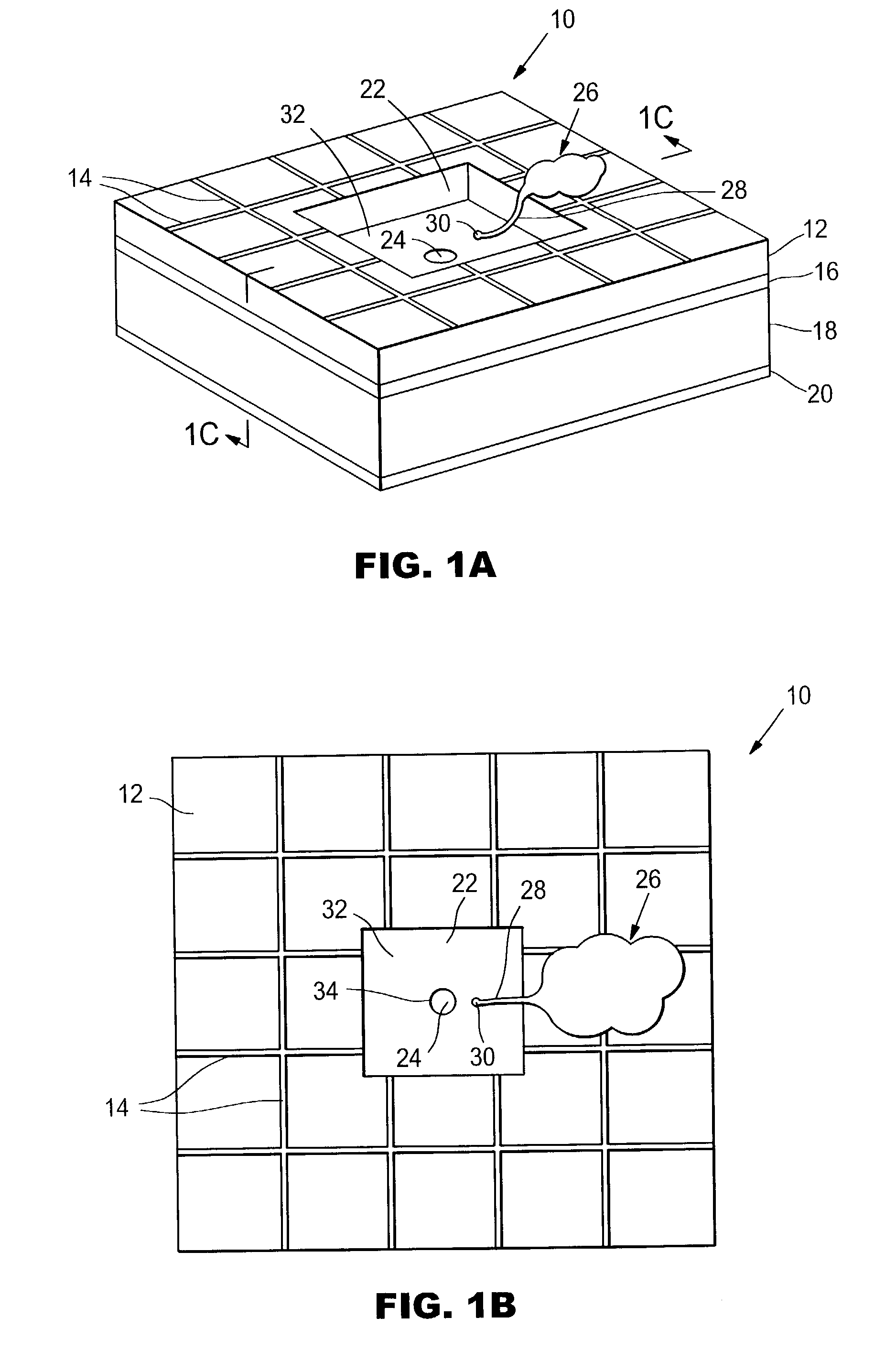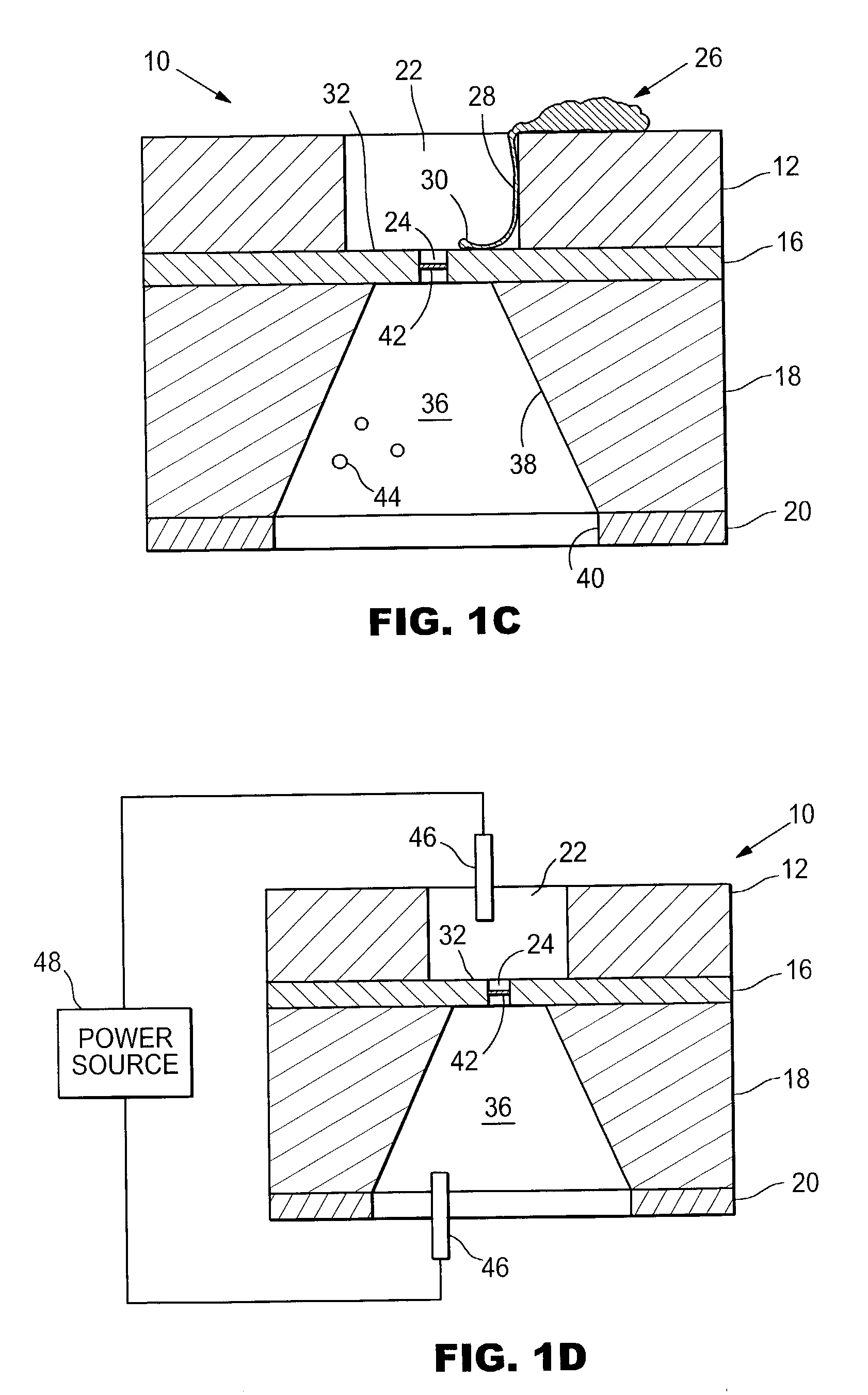Artificial synapse chip interface for electronic prosthetic retina
a technology of electronic prosthetic retina and synaptic synapse, which is applied in the direction of prosthesis, artificial respiration, therapy, etc., can solve the problems of permanent damage to photoreceptors, no effective treatment for most patients, visual impairment or blindness, etc., and achieves less power for stimulation, influence the behavior of a cellular system, and high spatial resolution
- Summary
- Abstract
- Description
- Claims
- Application Information
AI Technical Summary
Benefits of technology
Problems solved by technology
Method used
Image
Examples
example 1
Microfabrication of Apertures
[0079]Microfabricated apertures on a silicon chip surfaces have been made using the Stanford Nanofabrication Facility. Microfabricated wells with microfabricated apertures are shown in FIG. 2. Standard silicon processing techniques were adapted for producing micrometer and nanometer-sized apertures in a silicon nitride membrane. Using low-pressure chemical vapor deposition (LPCVD), silicon nitride was grown on the surface of orientation silicon wafers. A combination of lithography to define the structures in a photosensitive polymer was followed by plasma etching to pattern the structures in the silicon nitride creates apertures on one side of the wafer and an etchant masking layer on the other side. An anisotropic etchant, such as tetramethylammonium hydroxide (TMAH), was used to remove the silicon along the {111} crystal plane, but leave the silicon nitride unaffected. This produced a via hole (a connecting passageway) beneath the aperture, exposing t...
example 2
Device Fabrication and Optimization
[0083]This Example describes the manufacture and optimization of devices embodying features of the invention for use in forming bilayer membranes across the microfabricated apertures of the devices. Chips were made with surface areas of about 1 cm2 and with a final thickness of roughly 0.5 mm. Circular apertures of 25 μm through 250 μm (diameter) were plasma etched in 500 nm thick silicon nitride. The chips were covered in a thick polyimide, except for a square region of exposed silicon nitride 500 μm on a side.
[0084]Fabrication was done at the Stanford Nanofabrication Facility (SNF) with 4 inch, orientation, boron-doped, double-polished silicon wafers, nominally 500 μm thick. Using low-pressure chemical vapor deposition (LPCVD), a thin layer (500 nm) of silicon nitride was grown on the surface of the wafers. Standard contact photolithography and plasma etching of the silicon nitride was used to define the small features (e.g., the apertures). The...
example 3
Bilayer Formation Across Silicon Nitride Apertures
[0093]Lipid bilayers were formed by the method of Montal and Mueller (1972). In practicing the Langmuir-Blodgett technique, one raises two lipid monolayers across an aperture, allowing the lipids to align their hydrophobic tail portions across the aperture so as to form a lipid bilayer. Because of the hydrophobic nature of the lipid tails, in order to form stable bilayers the surface of a BSP must also be hydrophobic. If the substrate is hydrophobic, the lipids can smoothly transition from coating the substrate to spanning the aperture. To reverse the wetting properties of the naturally hydrophilic silicon nitride, the silicon nitride was coated with an alkylsilane (octyltrichlorosilane). Application of this coating was quite simple and very effective. It was not found to be possible to form a bilayer with untreated devices. Use of longer carbon chain silanes or alternative materials to make the surface even more hydrophobic would fu...
PUM
| Property | Measurement | Unit |
|---|---|---|
| thick | aaaaa | aaaaa |
| diameter | aaaaa | aaaaa |
| diameter | aaaaa | aaaaa |
Abstract
Description
Claims
Application Information
 Login to View More
Login to View More - R&D
- Intellectual Property
- Life Sciences
- Materials
- Tech Scout
- Unparalleled Data Quality
- Higher Quality Content
- 60% Fewer Hallucinations
Browse by: Latest US Patents, China's latest patents, Technical Efficacy Thesaurus, Application Domain, Technology Topic, Popular Technical Reports.
© 2025 PatSnap. All rights reserved.Legal|Privacy policy|Modern Slavery Act Transparency Statement|Sitemap|About US| Contact US: help@patsnap.com



